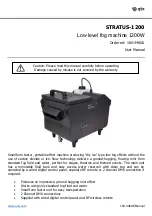
Contact your local dealer.
Supplies
1 Cloth Guide (1)
1 Folded Edge Guide (2)
2 Fixation Screws (3)
1
2
3
4
6
7
5
8
Additionally required
Cover Stitch Compensation foot (= standard accessory with every CS ma-
chine)
Application
The Hemmer Guide helps folding the hem and assures perfect placement
of the upper hem edge during cover stitching. It can be used with different
fabrics, knits or wovens, and is suitable for light to medium weight materials.
The materials need to be slid trough the guide without resistance.
For your safety
Before using the accessory, please read the instruction manual of the over-
lock machine and the accessory.
Assembly
➢
Place the Cloth Guide onto the CS Insert (4)
➢
Place the Folded Edge Guide on top of it.
➢
Fit the two Fixation Screws through the two parts and tighten slightly.
Adjustment
➢
The Cutting Edge Guide (5, left guide) is lined up with the left Coverstitch
needle.
➢
By loosening the upper adjustment screw (6) adjust the Outer Folded
Edge Guide (7) to the desired seam width in a range of 15 - 23mm (1/2” -
7/8”).
➢
Adjust the Cloth Guide (8) into the Folded Edge Guide, leaving 2 to 4mm
(approx. 1/8”) open, depending on the thickness of the fabric.
➢
Tighten the Fixation Screws and the adjustment screw securely.
➢
The fabric needs to move freely without resistance! Consider cross-seams
if applicable.
Stitches, Threading, Settings
➢
Thread the Overlocker for 3-Needle or 2-Needle Coverstitch wide or nar-
row. Always use the left needle.
➢
Set the stitch length to 3 – 4.
➢
Attach the Coverstitch Compensating foot.
Procedure
➢
Pre-fold the seam and slide it into the guide by placing the cutting edge at
its guide, having the folded edge fed softly in the hemmer guide.
➢
Lower presser foot and sew while guiding the fabric cutting edge neatly
along its guide and supporting the fabric in front of the Hemmer Guide.
➢
Before the end of the seam in a curve or tube, stop before the first stitches
reaches the Hemmer Guide.
➢
Remove the fabric from the guide. By guiding the fabric manually, contin-
ue stitching until some stitches are sewn over the first stitches.
➢
Raise the presser foot and remove the seam.
➢
Secure as project requires.
Hemmer Guide for Coverstitch
Optional Accessories
34


































